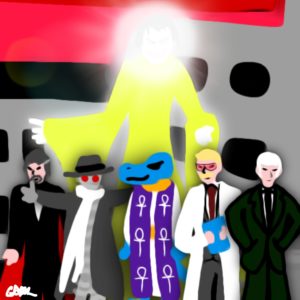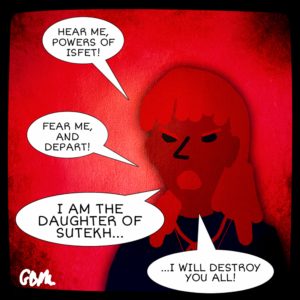The Scarlet Nemesis is the third chapter in my “Apocalypse” trilogy (following His Nocturnal Majesty and Our Lady of Thrones). It follows the younger Shieldmaiden of Set as she hunts down the Warlock across multiple alternate realities. It is currently available for free on Bandcamp.com, and it will soon be available for purchase on Amazon, Spotify, iTunes, and other digital music platforms as well. The album can also be enjoyed for free on YouTube.
Where’s the Warlock?

After the final battle in Our Lady of Thrones (“Defy the Ungod“), the younger Shieldmaiden of Set leads an attack squad back into the ruins of Atlanta, Georgia. Their target is the Warlock, the final and most powerful member of the triumvirate that ruled the now fallen Kingdom Guard. The evil magician is still holed up in his empire’s ruined capital, and he is currently working a bizarre ceremonial ritual at his headquarters.
The Scarlet Nemesis (Main Theme)

The Shieldmaiden and her team break into the Warlock’s headquarters and fight off his last remaining followers; but not before his evil spell is completed. He successfully opens a gateway to another world, and the Shieldmaiden jumps in after him at the very last second.
Across the Multiverse in 80 Seconds
The Shieldmaiden and the Warlock wrestle each other through a wormhole stretching across multiple universes. The Warlock kicks the Shieldmaiden away, and she is cast into some unknown world, where she blacks out.
The Imperishable Ones

The Shieldmaiden awakens, finding herself in the Desert of Set. Beside her is are several Knights in Sutekh’s Service who fell during the exorcism of the Ungod in His Nocturnal Majesty (“Giver of Winds“). The Knights explain to the Shieldmaiden that Set brought her to safety here in His heaven; but since she isn’t dead yet, she must return to one of the many worlds of the living. Whether she chooses to return home or continue her quest against the Warlock is her decision.
Ancient Enemy (Disciple of the Worm)

The Imperishable Ones tell the Shieldmaiden of Set about the Warlock’s history. They tell her he is not a human being at all, but an uncreated monster from before the dawn of time. He has many names and faces, and he orchestrates a unique apocalypse for every universe he visits. He is the alpha of all evil masterminds, and he will settle for nothing less than the total annihilation of everything that exists—including himself in the end.
The Sword and the Scarab

Set appears and gives the Shieldmaiden two gifts: a khepesh sword and a scarab amulet. The sword has been forged directly from Set’s iron bones, and it is both indestructible and extremely deadly to all creatures of isfet. It also glows bright red whenever such creatures are near, to help identify the Warlock. The amulet, meanwhile, can instantly return the Shieldmaiden to her home universe whenever she wishes. Set then asks the Shieldmaiden how she would like to proceed, and she chooses to continue her quest. He sends her to the universe where the Warlock is currently located, and the Shieldmaiden goes to work.
Holiday Fear
The Warlock has launched a multimillion dollar toy company, and all of his products have been hexed to kill sleeping families across the world on Christmas Eve. The global paranoia produced by this single act of terror will make the Ungod visible to everyone in this world, resulting in the same apocalypse suffered in the Shieldmaiden’s home universe. Can the Shieldmaiden save the holidays and stop the Ungod’s return?
Mesozoic
The Shieldmaiden pursues the Warlock to an alternate earth where humans never came into existence. This version of earth is ruled by a civilization of reptile people instead. These peaceful creatures are terrified by the Shieldmaiden’s appearance, having never seen a human before. The Warlock impersonates a reptilian priest of the crocodile god Sobek, using this position to stir up fear among the populace. But when the Shieldmaiden rescues a nursery full of reptilian toddlers from burning in a fire, their parents help her escape.
Bacillus Pestis
The Warlock has assumed control of the Illuminati, and he is using its top scientists to develop a mutant strain of bubonic plague. This strain infects and kills its hosts within minutes, reducing them to awful bloody heaps. The Illuminati’s members think the Warlock is giving them a vaccine so they can use the disease to extort every world government. In reality, they are being infected with the bacteria and will be the first to die. The Warlock intends to let this plague drive the entire human race into extinction. Can the Shieldmaiden avert this horrific act of terror before it’s too late?
Graveyard Minds
The Shieldmaiden enters a timeline where the Warlock is funding a mad scientist named Quantamaker, who has discovered the secret to physical immortality. The only problem is, Quantamaker’s procedure results in complete annihilation of the soul. His patients do become physically indestructible and cease to age; yet they also become cold, motionless voids that just stand there, staring blankly into eternity, with no will or motivation to do anything. Worse still, the Warlock has weaponized Quantamaker’s procedure and plans to zombify every living creature in this way, so as to throw all of nature out of balance.
Hell is Where the Heart is
The Shieldmaiden wakes up as a patient at a maximum security psychiatric ward. The head psychiatrist is none other than the Warlock, who is hypnotizing his patients to believe they must destroy entire neighborhoods for “Satan,” then arranging for them to escape. This is intended to spark a global witch hysteria that will kick off the Ungod’s return—a “rerun” of one of the Warlock’s schemes in Our Lady of Thrones (“Satanic Panic“). Can the Shieldmaiden resist her captor’s evil spell and break free to bring him down? Or will the Warlock succeed in appealing to her dark side and convert her to the ways of isfet?
The War Across the Worlds

The Shieldmaiden coordinates a full scale synchronized attack against the Warlock’s operations across each of the preceding universes she has visited (“Holiday Fear,” “Mesozoic,” “Bacillus Pestis,” “Graveyard Minds,” and “Hell is Where the Heart is“). She brawls with the evil wizard and chases him through yet another wormhole that stretches across the multiverse.
Dispel the Ungod
The Shieldmaiden pursues an injured Warlock to a desolate world entirely devoid of life. They have their final showdown, in which she finally separates his torso from his legs with her magic sword. She recites an execration spell as she watches him die, staring him coldly in the eye as she does so. But despite her victory, the Warlock never stops grinning, not even when he gives his final breath.
She Before Whom the Sky Shakes

Having vanquished her foe, the Shieldmaiden of Set finally uses the magic amulet she received from the Imperishable Ones. She returns home to her own universe, finding the task force she led still waiting for her. She shows them the decapitated head of the Warlock, and everyone cheers.
The Eternal Conflict (Finale)
In each world she has visited, the Shieldmaiden has made friends and allies, uniting them to defend Ma’at against the powers of isfet. Thanks to her example, each of these brave souls now understands that Ma’at is a delicate balance and is always in danger. We can’t just sit here, hoping for a happy ending; even Gods must fight for what They wish to save.












